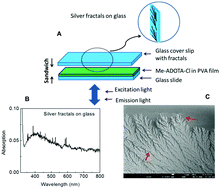Sandwich type plasmonic platform for MEF using silver fractals
Abstract
In this report, we describe a plasmonic platform with silver fractals for metal enhanced fluorescence (MEF) measurements. When a dye containing surface was brought into contact with silver fractals, a significantly enhanced fluorescence signal from the dye was observed. Fluorescence enhancement was studied with the N-methyl-azadioxatriangulenium chloride salt (Me-ADOTA·Cl) in PVA films made from 0.2% PVA (w/v) solution spin-coated on a clean glass coverslip. The Plasmonic Platforms (PP) were assembled by pressing together silver fractals on one glass slide and a separate glass coverslip spin-coated with a uniform Me-ADOTA·Cl in PVA film. In addition, we also tested ADOTA labeled human serum albumin (HSA) deposited on a glass slide for potential PP bioassay applications. Using the new PP, we could achieve more than a 20-fold fluorescence enhancement (bright spots) accompanied by a decrease in the fluorescence lifetime. The experimental results were used to calculate the extinction (excitation) enhancement factor (GA) and fluorescence radiative rate enhancements factor (GF). No change in emission spectrum was observed for a dye with or without contact with fractals. Our studies indicate that this type of PP can be a convenient approach for constructing assays utilizing metal enhanced fluorescence (MEF) without the need for depositing the material directly on metal structures platforms.


 Please wait while we load your content...
Please wait while we load your content...